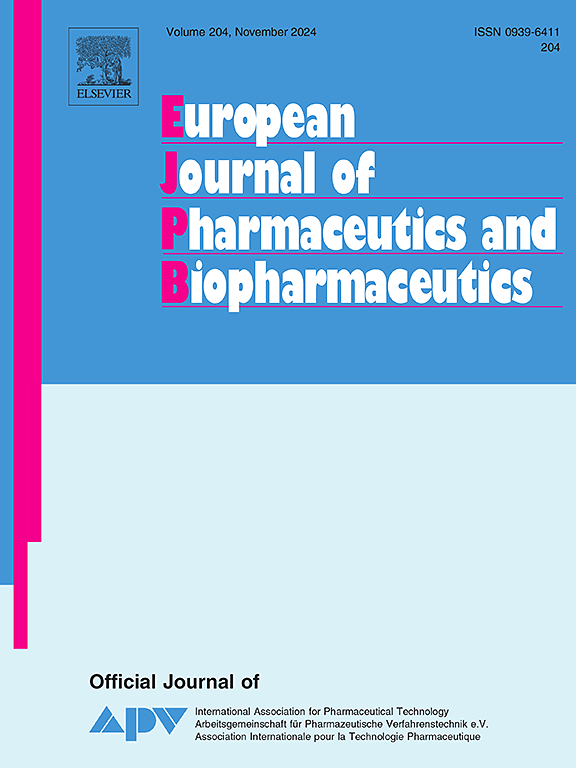Effect of polymer architecture on the properties and in vitro cytotoxicity of drug formulation: A case study with mono- and di-gradient amphiphilic poly(2-Oxazoline)s
IF 4.4
2区 医学
Q1 PHARMACOLOGY & PHARMACY
European Journal of Pharmaceutics and Biopharmaceutics
Pub Date : 2025-01-22
DOI:10.1016/j.ejpb.2025.114635
引用次数: 0
Abstract
Due to the straightforward single-step synthesis, amphiphilic gradient copoly(2-oxazoline)s are becoming more popular alternative to their block analogue for the development of next-generation drug delivery systems. Here, we investigated the influence of polymer architecture on the physiochemical and biological assessment of nanoformulations formed by the self-assembly of gradient copoly(2-oxazoline)s. Two different architectures were synthesized: hydrophilic-grad-hydrophobic (mono-gradient) and hydrophobic-grad-hydrophilic-grad-hydrophobic (di-gradient) which contained a hydrophilic monomer, 2-ethyl-2-oxazoline (EtOx) and a hydrophobic monomer, 2-phenyl-2-oxazoline (PhOx). Di-gradient copolymers self-assembled in the presence of a hydrophobic model drug, curcumin and formed monodispersed or slightly polydispersed nanoparticle solution. On the other hand, mono-gradient copolymers formed polydispersed nanoparticle solutions. Di-gradient copolymer was slightly more efficient to solubilize curcumin. Mono-gradient copolymer nanoparticle showed faster monomer chain exchange kinetics and comparatively less stability in the presence of serum albumin. At longer incubation times, faster drug release was observed from the mono-gradient copolymer nanoformulations. Cytotoxicity of free curcumin and curcumin loaded nanoparticles in cancer cell of U87 MG (human glioblastoma cell) was dose and time-dependent, whereby the significant cell death occurred after 48 h. Curcumin-loaded mono-gradient copolymer nanoparticles inhibited U87MG cancel cell growth to a large extent compared to the di-gradient copolymer nanoparticles.

聚合物结构对药物配方性质和体外细胞毒性的影响:以单梯度和双梯度两亲性聚(2-恶唑啉)为例。
由于简单的单步合成,两亲性梯度共聚(2-恶唑啉)正成为下一代药物递送系统开发中更受欢迎的替代物。在这里,我们研究了聚合物结构对梯度共聚(2-恶唑啉)自组装形成的纳米配方的理化和生物学评价的影响。合成了亲水性-级疏水性(单梯度)和疏水性-级亲水性-级疏水性(双梯度)两种不同的结构,其中包含亲水性单体2-乙基-2-恶唑啉(EtOx)和疏水性单体2-苯基-2-恶唑啉(PhOx)。双梯度共聚物在疏水模型药物姜黄素存在下自组装,形成单分散或微多分散的纳米颗粒溶液。另一方面,单梯度共聚物形成了多分散的纳米粒子溶液。双梯度共聚物对姜黄素的溶解效率略高。单梯度共聚物纳米颗粒在血清白蛋白存在下表现出更快的单体链交换动力学和相对较差的稳定性。在较长的孵育时间,从单梯度共聚物纳米配方中观察到更快的药物释放。游离姜黄素和负载姜黄素纳米颗粒对U87 MG(人胶质母细胞瘤细胞)的细胞毒性具有剂量和时间依赖性,在48 h后发生显著的细胞死亡。与载姜黄素的单梯度共聚物纳米颗粒相比,载姜黄素的单梯度共聚物纳米颗粒在很大程度上抑制了U87MG取消细胞的生长。
本文章由计算机程序翻译,如有差异,请以英文原文为准。
求助全文
约1分钟内获得全文
求助全文
来源期刊
CiteScore
8.80
自引率
4.10%
发文量
211
审稿时长
36 days
期刊介绍:
The European Journal of Pharmaceutics and Biopharmaceutics provides a medium for the publication of novel, innovative and hypothesis-driven research from the areas of Pharmaceutics and Biopharmaceutics.
Topics covered include for example:
Design and development of drug delivery systems for pharmaceuticals and biopharmaceuticals (small molecules, proteins, nucleic acids)
Aspects of manufacturing process design
Biomedical aspects of drug product design
Strategies and formulations for controlled drug transport across biological barriers
Physicochemical aspects of drug product development
Novel excipients for drug product design
Drug delivery and controlled release systems for systemic and local applications
Nanomaterials for therapeutic and diagnostic purposes
Advanced therapy medicinal products
Medical devices supporting a distinct pharmacological effect.

 求助内容:
求助内容: 应助结果提醒方式:
应助结果提醒方式:


